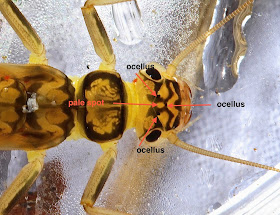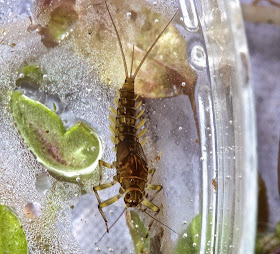Thursday, March 26, 2015
Buck Mt. Creek yields the Nemourid stonefly, Prostoia completa (Central Forestfly)
This morning it was not in my plans to go to a stream. But about 10:00 am the sun popped out, so I was off to Buck Mt. Creek. And I was rewarded.
This is a small stonefly that I've only seen a few times -- once before at Buck Mt. Creek (3/1/11) and a few years ago at the Rapidan River (downstream from the section I normally visit). Nemourid stonefly (Forestfly), Prostoia completa, for which the common name is "Central Forestfly."
The Prostoia nymphs are very small -- 5-6 mm when they're mature -- and I had one that was 5 and one that was 6. The pronotum provides one of the keys to genus ID: "rounded pronotum with no marginal fringe (or of very small spines)." (Beaty, "The Plecoptera of North Carolina," p. 4) We can see the those small spines in this picture,
and we can also see a key feature in the species ID: "white spots on head covering both sides of Y-shaped ecdysial line." (Brigham, Brigham, and Gnilka, Aquatic Insects of Oligochaetes of North and South Carolina," p. 5.20) No question about it. Actually that feature shows up quite well in the live shots.
Nice find, and I'm pleased that my photos turned out. But, I have to admit that the photos I took of this nymph on 3/1/11 were actually better!
Alas!
______________________
The water was high, and as you can probably tell, the leave packs were quite silted up (= dirty nymphs), so I didn't search for a lot having found three P. completas without looking real hard. But I did find a gorgeous, fully mature Helopicus subvarians Perlodid.
18 mm -- that's a pretty big stonefly!
________________
Sunshine coming for Sunday. I'll be spending the day in Sugar Hollow.
Saturday, March 21, 2015
Just more beautiful stoneflies from the Rapidan River
The Rapidan River is chock-a-block full of nymphs at the moment, as it always is in the spring. And this is one of the stoneflies I was hoping to find: Perlodidae, Isogenoides hansoni. This is still the only place that I've found these beautiful nymphs, and as I suspected, they're pretty close to being mature. Still, not yet quite as mature as the nymph that I found on 3/24/11.
I think I'll just focus on photos today, with minimal comments on features we use for ID. For I. hansoni, the banding on the abdominal terga is clearly distinct, but I always look at the head: "ocellar triangle bordered by dark but with pale central spot." (Beaty, "The Plecoptera of North Carolina," p. 22)
There you go.
Another treasure today -- an Agnetina capitata (Perlidae) that still has a ways to go before it's mature.
Another species that, to date, I've only found in this river. Agnetina common stones have a setal row on the occiput and very clear anal gills. A. capitata has a light area between the lateral ocelli that leads towards the median ocellus and an "apparent" mid-dorsal longitudinal stripe on the terga. (Beaty, "The Plecoptera of North Carolina," p. 15)
These nymphs will mature in late May and June. Found this one last year on 5/24.
But today, those wing pads were just starting to curve.
_________________
And then there was this HUGE Giant stonefly, Pteronarcys biloba.
That big boy would make a real meal for the native Brookies that live in this stream. It ran about 2 inches. But it was so active, and so big, that it kept crawling out of my petri dish. I had to retrieve it a number of times.
________________
Mayflies? Of course. I only photographed two, two that were very mature. The spiny crawler, Ephemerella subvaria,
and the small minnow mayfly that we find only in clean mountain streams, Baetis tricaudatus.
The short middle tail (caudal filament) is very clear in both of those photos.
________________
It's a special river, and these are all special insects.
1. Isogenoides hansoni: "Relatively rare" according to Beaty (p. 22).
2. Agnetina capitata: "Listed by NC Natural Heritage Program as Significantly Rare (2010)." (Beaty, p. 15)
3. Pteronarcys biloba: tolerance value of 0.0.
4. Ephemerella subvaria: "Rare," according to Beaty. ("The Ephemeroptera of North Carolina," p. 28)
5. and Baetis tricaudatus: tolerance value of 1.5.
________________
Off to Buck Mt. Creek on Tuesday where we should find a fair number of Isoperlas (Perlodid stoneflies), and then to the small mountain streams in Sugar Hollow next weekend.
Most common insect today: Perlodid stonefly, Isoperla montana/kirchneri. The leaf packs are crawling with them at the moment. I'd look for the "Yellow Sallies" to hatch sometime in late April.
Thursday, March 12, 2015
Still waiting to hear: is it Isoperla kirchneri?
Finally. The snow has melted and the temps have warmed up. The bad news? Most of our streams are too high to wade. But not so the small streams in Sugar Hollow.
And I found one of the insects I was hoping to see: Perlodid stonefly, Isoperla kirchneri or Isoperla montana -- still no word on Kondatrieff's monograph that, we hope, will settle the matter. But this is the only "type" of I. montana/kirchneri that I find in these little streams. Note: no "bars" at the back of the head; wide pale area in the pronotum; and the pale spot in the ocellar triangle is almost completely enclosed.
But I still need to find a nymph that's fully mature to see if these distinctive traits are there right to the end. For more on this issue, see the entry posted on 1/25 of this year.
_______________
The most common insect I found today was the pronggilled mayfly, Paraleptophlebia mollis.
There were lots and lots of them in the leafpacks. Ought to be hatching in April or May. We've talked about the species ID earlier this winter (1/18, 1/21). To be sure of the ID, we have to look at the mandibles -- microscope work. "Nymph uniformly brown in color; incisors of mandible strongly directed inward....Paraleptophlebia mollis." (See p. 3.60 in Brigham, Brigham, and Gnilka, ed., Aquatic Insects and Oligochaetes of North and South Carolina.) No question about it.
________________
Not much else to get excited about -- but it sure was good to get back to a stream.
Other photos.
1. Leuctridae, genus Leuctra. Common name, "Appalachian Needlefly"
2. Flatheaded mayfly, Maccaffertium pudicum. (Commonly found with M. meririvulanum in these small, headwater streams.)




































